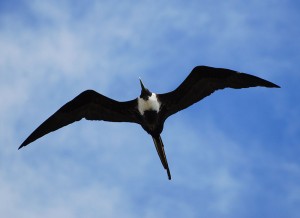Even though the summer sun can be quite hot here in Boca, in one respect we don’t have it nearly so bad as people who live farther north. Our maximum temperature is usually quite a bit cooler than the maximum in places like Washington, D.C. or New York. We may get warm sooner, and stay warm longer, but for us a killer heat wave is the mid-90s.
As Henry, Portier, and Coyne describe it, the average annual maximum temperature in southern Florida is 5° less than “most areas east of the Mississippi River and south of the Great Lakes” (7).
That said, June was an extremely hot month. And July hasn’t started off much cooler. So we’ve gotten in the habit of going to the beach early in the morning (by early I mean the crack of nine, not the dawn patrols of my misspent youth) on the weekends. That gives us plenty of time to enjoy the beach before the madding crowds arrive.
Eric loves the water, particularly when it’s as calm as it was last weekend. Glassy water, bright but not yet punishing sun: a recipe for fun!
This weekend, though, the winds were out of the east, and the ocean was quite a bit rougher. We still had fun, but the waves even in the shallows were stronger, and we didn’t last nearly as long. One of the last waves rolled us over and we got a dunking that took a bit of the fun away. Home time!
Mommy and Daddy got a good bird sighting out of the rough conditions, though: a Magnificent Frigatebird, fairly uncommon in Palm Beach County (image from Wikipedia, as I rarely take my camera to the sand and salt of the beach):

Our bird was traveling incognito, though, with neither white on the throat (female field mark) nor red throat sac (male field mark) visible. I assume this means it was a male with its throat sac hidden, because females and juveniles always display the white.
It was definitely a frigatebird, though; there’s no mistaking that wing shape or the piratical air, or the ease with which it plies its trade in the breezes over the beach. It owes this last trait to the fact that it has “the greatest ratio of wing surface area to body weight of all living birds. This fact, together with the bird’s very long, deeply forked tail, makes the frigatebird aerodynamically unrivaled for soaring and maneuvering” (51). (I would say that the Swallow-tailed Kite puts on a pretty good show, but for all its grace it is noticeably “heavier” on the wind than the man-o-war bird.)
Stevenson and Anderson’s map shows only spring and winter sightings from Palm Beach County; nevertheless, I’ve seen them often enough in summer that I’m not in any rush to report this sighting. (Our Palm Beach County Checklist of Birds lists them as unusual in spring, fall, and winter, and Rare (even rarer than unusual) in summer).
References
Henry J.A., Portier K.M., & Coyne, J. 1994. The Climate and Weather of Florida. Sarasota: Pineapple Press.
Hope, B. 2003. Palm Beach County Checklist of Birds. Audubon Society of the Everglades.
Stevenson, H.M., & Anderson, B.H . 1994. The Birdlife of Florida. Gainesville: UP of Florida.
